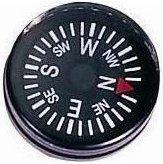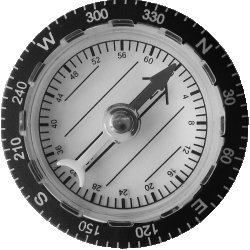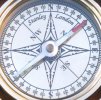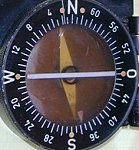
Compass Measurement Units
Different Compass Units of Measure
There are a few different ways a compass is divided into units. Depending on the use for the compass, different units of measure may be more useful:
 Points:
Points:
Cheap, basic compasses may be marked with the cardinal points of North, East, West, and South with the intercardinal points of North East, South East, South West, and North West between them. These compasses just provide your general direction when accuracy is not necessary. See Compass Reading for more info.
 Degrees:
Degrees:
A compass divided into 360 degrees is the most common unit of measurement. Each degree is divided into 60 minutes, each minute into 60 seconds. A handheld compass is not able to measure down to a minute, let alone a second, but those units are used for precise locations using latitude and longitude.
North is at 0 degrees (and 360 degrees), East is 90 degrees, South is 180 degrees, and West is 270 degrees.
 Some compasses may be marked in degrees only from 0 to 90. See this example. It has 0 to 90 degrees from North to East. It also has 0 to 90 degrees from South to East, South to West, and North to West.
Some compasses may be marked in degrees only from 0 to 90. See this example. It has 0 to 90 degrees from North to East. It also has 0 to 90 degrees from South to East, South to West, and North to West.
With this style of compass, readings such as North 20 degrees East are used. That means 20 degrees towards East from North. A bearing of South 70 degrees West would be the same as 250 degrees on a normal 360 degree compass (180 degrees for South plus 70 degrees).
A bearing of South 15 degrees East would be the same as 165 degrees (180 degrees minus 15 degrees).
 Mils:
Mils:
Another unit of measure, the radian, is used mainly by militaries in artillery, tank, and mortar gunnery.
There are 2 PI radians in a circle. PI is a constant of approximately 3.1416. That is 2 * 3.1416, or 6.283 radians.
Divide each radian into 1000 mil-radians and you see there are 6283 mil-radians in a circle. Mil-radians are called mils for short.
17.78 mils equal 1 degree.
Compass use of mils typically rounds 6283 to 6400 for simplification. Some foreign militaries have simplified the other direction and divided the compass face into 6000 units, exactly like the face of a watch, with 100 units the same angle as a minute on the watch face.
Using mils, the actual size of an object observed in the field can be estimated. An object that appears to be n mils wide when it is 1000 units away from you, is actually n units wide - the units used does not matter, feet, yards, meters, miles.
A train that appears to be 300 mils long and is 1000 feet distant is actually 300 feet long. Or, two vehicles that appear to be 200 mils apart and are 1000 meters away, are actually 200 meters apart.
(The compass in the Degrees section actually has MILS in black numbers on the inner portion of the face.)
Grads:
The grad is a metric unit of measure, not commonly used. There are 400 grads in a circle where 100 grads = 90 degrees. Each grad can be divided into 100 centigrads (c). Each centigrad can be divided into 100 centi-centigrads (cc).
 Where is it always 90 degrees, but never hot?
Where is it always 90 degrees, but never hot?At the North and South poles. |
| Search Google News for more 'Lost Hiker' news items. |
| 25 Dec 2025 - Lost Edgewood Park hiker found within 12 hours |
| 25 Dec 2025 - 63 |
| 23 Dec 2025 - Two lost hikers rescued from frigid Catskill Mountains trail |
| 30 Oct 2025 - Returning to the Appalachian Trail After the Murder That Changed It |
| 20 Nov 2025 - How an Ultrarunner Saved a Lost Hiker's Life |
| 26 Dec 2025 - SMC Hiker Who Went Missing Christmas Eve Found Safe Christmas Morning |
Comments:
Jan 09, 2017 - dave
size = mils*(distance/1000)
If something looks 4 mils wide and is 2000 meters away:
size = 4 mils * (2000meter/1000meter)
size = 8 meters
We used the cardinal system on magnetic down to quarter points when I started at sea. These worked out at about every 3 degrees - which was good enough back in the day. You worked from the 8 major points - starting from N this would be: N; NE; E; SE etc etc. Using quarter points would be N; N 1/4 E; N 1/2 E; N 3/4 E; N x (say 'bi') E; N x E 1/4 E; N x E 1/2 E; N x E 3/4 E; NNE. Now you came up the other way from the NE and not the N: We were at NNE so next is NE x N 3/4 N; NE x N 1/2 N; NE x N 1/4 N; NE x N; NE 3/4 N; NE 1/2 N etc etc you get the idea (I hope!) Steering a sailing ship to 3 degrees was good enough - when you were out in a gale and full of grog. If you get the hang of it you will have more compass knowledge than 99% of seamen out there today!!
Try this: See an object off in the distance, measure the bearing in mils then walk perpendicular to that bearing (i.e. left or right) and count your steps. Divide those steps by the difference in bearings as measured in mils/10 (converts mils to radians) and you have the distance to the object in steps
Ask a Question
More Map and Compass Resources at CompassDude.com



Recent Comments